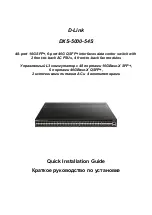
User Manual: Switch-Control 63400
Page 11
The Start/End key sequences to control the station routes are as follows:
1.
First key 1 is pressed as the Start key and then key 2 as the end key, Route 1 of Group 1 of the
Intellibox sets the train entrance from A to Track 1.
2.
First key 1 is pressed as the Start key and then key 3 as the end key, Route 2 of Group 1 of the
Intellibox sets the train entrance from A to Track 2.
3.
First key 2 is pressed as the Start key and then key 1 as the end key, Route 3 of Group 1 of the
Intellibox sets the train exit from Track 1 to A.
4.
First key 3 is pressed as the Start key and then key 1 as the end key, Route 4 of Group 1 of the
Intellibox sets the train exit from Track 2 to A.
The Switch-Control is programmed using the appropriate LNCVs as described in Sections 4.2 and 5.6
above. The necessary programming information is as follows:
Start key 1 and End key 2 switch accessory address 2001 to “red,” and activate Route 1 of Group 1:
LNCV 112 = 2001 0
Start key 1 and End key 3 switch accessory address 2001 to “green,” and activate Route 2 of Group 1:
LNCV 113 = 2001 1
Start key 2 and End key 1 switch accessory address 2002 to “red,” and activate Route 3 of Group 1:
LNCV 121 = 2002 0
Start key 3 and End key 1 switch accessory address 2002 to “green,” and activate Route 4 of Group 1:
LNCV 131 = 2002 1
6.7 Accessing a route in the IB-Switch using a single key
A set of switching commands for a route may be stored in the IB-Switch as one of its 40 routes. The red
key of this route on the IB-Switch must be assigned a feedback address and a condition, “free” or
“occupied.” This allows the route to be called remotely from the Switch-Control. (For more information,
please see the IB-Switch manual.)
Example:
A key on the TDCB is connected to input 6 of the Switch-Control. This key will be used to call a route in
the IB-Switch that has been assigned to feedback address 21 with the condition “occupied.” The following
LNCV must be programmed in the Switch-Control:
LNCV 166 = 0021 3
6.8 Accessing routes in the IB-Switch using Start&End key combinations
The track plan shown in Application Example 6.6 above will be used with the IB-Switch. The switching
commands of the four desired routes must first be stored in the IB-Switch. The red keys associated with
each of these IB-Switch routes are also programmed with a feedback address and condition, “free” or
“occupied.” This allows each route to be called remotely from the Switch-Control using Start&End key
combinations. (For more information, please see the IB-Switch manual.)
Example:
Feedback addresses 501 to 504 will be used with the condition “occupied” to access each of the four routes
stored in the IB-Switch. To use the routes according to Example 6.6 above, the Switch-Control must be
programmed as in Sections 4.2 and 5.6 by setting the following LNCVs:
Start key 1 and End key 2 send feedback address 501 “occupied,” which activates Route 1:
LNCV 112 = 0501 3
Start key 1 and End key 3 send feedback address 502 “occupied,” which activates Route 2:
LNCV 113 = 0502 3































